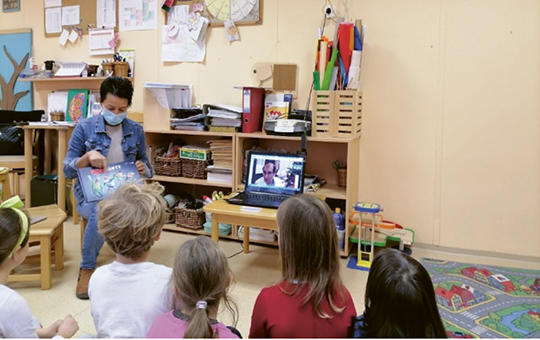[ Thrombolysis and/or thrombectomy have been proven effective in the treatment of acute ischemic stroke. Due to the narrow time window, the number of patients suitable for these treatments is low. The main limitation is the pre-hospital stage, few people call an ambulance in time. The delay may be caused by the population’s insufficient health knowledge, but also by the loneliness and isolation of the population most prone to stroke. Among the latter, there are many grandparents who spend considerable time with their grandchildren. This gave rise to the idea of educating even younger children about the symptoms of a stroke, enabling them to call an ambulance if necessary. To this end, we adapted the Angels Initiative project previously tested in Greece. The Hungarian pilot study Budapest District XII. took place in district kindergartens. The Angels’ original role-playing program could not be implemented due to the COVID epidemic, so the necessity called for a new, Hungarian version: the online “Stroke Ovi” program. We introduced this in several stages, and in the third we also carried out an impact study.
We adapted the Angels Initiative’s international program and its Hungarian translation to our program. We prepared the original, live role-playing form, with a parent meeting in the selected “test kindergarten”. Due to the uncertainly lingering impact of the COVID epidemic, we reevaluated our plan, using the Hungarian storybook and take-home workbook created in the meantime, we developed our own online version in several kindergartens in Budapest. We held 10 and then 25 minute sessions a week for 5 weeks. In the third educational cycle, which always targets new groups, we already examined the impact of the program by taking pre- and post-tests, in which not only the children but also their parents participated. In addition to neurologists and kindergarten teachers, we also included psychologists and speech therapists in our work, because we believed that in a social environment that includes parents and children, results can only be achieved through multidisciplinary cooperation.
In the third cycle of the program, tests were taken before (pre-test) and after (post-test) among children and their parents. We only took into account those answers where we received an evaluable answer in the survey before and after the program. Our most important results: 1. there was no negative change in any question, so it was not the case that the total score of any question in the pre-test was higher than in the post-test. 2. The children learned that not only adults can call the ambulance. 3. Before the program, all children were already aware that if “someone is very ill”, the ambulance should be called. 4. Among the questions about stroke symptoms, it is important that hemiparesis, facial paresis and speech/language disorder are clear symptoms for children. Based on the parental questionnaires, the knowledge of the adults can be judged to be very good. The same number of correct answers were received during the pre-test and the post-test, on the basis of which we could not calculate a transfer effect. However, it is important that the parents considered the program useful, motivating and important for the children, so cooperation can be expected in the future.
The Hungarian “Stroke Ovi” program has so far proven to be clearly effective. This was proven by the impact assessments even if, instead of the original role-playing game, we implemented it “only” online due to the COVID epidemic. This constraint also forced and created a new “Hungarian version”. Despite the small number of samples caused by the circumstances, we consider this positive effect to be measurable. However, as the main result and evidence, we evaluated the children’s reaction, which took shape in spontaneous drawings and displayed professional values in addition to positive emotional reactions, such as the drawing of ambulances, the recurring representation of the 112 number. With the involvement of the media, we think online education is also a good option in the series of stroke campaigns, but we think the original role-playing form is really effective. At the same time, we can see that the application of the new method requires great caution due to the education of developing children. For this reason, results can only be achieved through social and multidisciplinary cooperation involving neurologists, psychologists, kindergarten teachers, and parents.]




